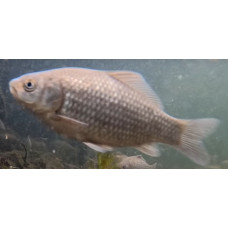Latin name
Carassius gibelio
Other names
Silver Prussian carp, Gibel carp, Carassius gibelio
Identification
The Prussian carp can be distinguished from the Crucian by its larger, lighter scales and smaller size. The colour of the scales is usually silver-grey or greenish-grey, but occasionally specimens with golden and even pinkish-orange colouring are found. The ratio of height to body length can vary considerably depending on habitat conditions. The first ray of the dorsal and anal fins is a hard serrated spine, the other rays are soft.
Distribution
Originally inhabited the Amur basin and adjacent waters. In the 60s of the XX century it was artificially spread in many waters of Siberia and Europe. Now it is introduced to North America, India and other regions. At the same time, it gradually replaced the crucian carp in European and Siberian reservoirs until the latter disappeared completely.
Habitat
Usually found near the bottom or in thickets of underwater vegetation. It is indifferent to water quality; under unfavourable conditions (drying up or freezing of the water body, low oxygen content in the water) it buries itself in mud and hibernates, and can remain in this state for a long time.
Size
Reaches 46.6 cm in length and up to 3 kg in weight. Individuals can live up to 10-12 years.
Life history and Behavior
It is mostly sedentary, but during spawning it is quite capable of leaving lakes for tributaries and ascending rivers. It can rise to the upper layers of water, for example during the period of mass insect migration. It forms schools, although large fish may remain alone.
Food and feeding habits
Omnivorous: aquatic and near-water invertebrates, insects and their larvae, algae, higher plants, detritus. Unlike the crucian carp, the silver carp feeds more on plant food and planktonic crustaceans.
Reproduction
Spawning is batch spawning, which can occur from one to three times a year, depending on water temperature. There are usually 4-6 times fewer males than females, and in some reservoirs there are no males at all. In such reservoirs, females spawn with males of related species (rutilus, crucian carp, tench, bream, Eurasian carp and others). There is no real fertilisation, as the sperm do not fertilise but only stimulate the development of the eggs. The offspring are all female. This type of reproduction is called gynogenesis.
| Classification | |
| Phylum | Chordata |
| Class | Actinopterygii |
| Squad | Cypriniformes |
| Family | Cyprinidae |
| Genus | Carassius |
| Species | C. gibelio |
| Features | |
| Conservation status | No information |
| Habitat | Bottom |
| Life span, years | 12 |
| Maximum body weight, kg | 3 |
| Maximum length, cm | 46,6 |
| Sailing speed, m/s | No information |
| Threat to people | Edible |
| Way of eating | Not predator |
Prussian carp
Tags: prussian carp


